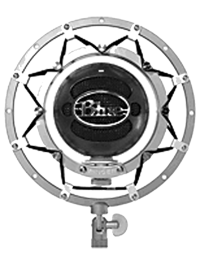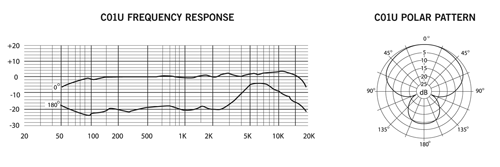 THE SAMSON C01U
THE SAMSON C01U
Samson’s C01U microphone is a USB version of their entry-level C01 medium-diaphragm condenser microphone. Like the Snowball, it outputs a 16-bit resolution signal, but unlike the Snowball it supports sample rates of 8, 11.025, 22.05, 44.1 and 48kHz. Samson is known for developing low-cost audio products, and the C01U is no exception with a suggested retail of $235 but a street price of under $80 (that’s some discount! Someone ought to talk to Samson’s marketing department about inflated list pricing).
The die-cast metal C01U microphone resembles a traditional side-address studio condenser mic, feels reasonably solid, and is nicely finished. It uses a 19mm cardioid back-electret capsule with a three-micron diaphragm, suspended on an internal shock mount. Its frequency response claims to be flat within 1dB over the audio range. Its maximum SPL specs out at an adequate 136dB, but there are no noise specs, a possible cause for concern. There are no pad or low-cut switches on the mic itself, although a software applet does provide a very effective low-cut filter with variable cutoff frequency. A green LED on the mic confirms that USB power is active.
It would seem that USB microphones have a genetic disposition towards low output levels. The C01U addressed the “low volume” issue right from the gate, by adding a two-stage variable gain cell inside the microphone before to the converter. If you just use the mic as it comes, your computer’s own system gain control actually controls the mic’s internal gain cell. However, as documented in the manual, you can also download Samson’s control panel applet, called Soft Pre, and this can be used to control the internal gain of the mic. Up to +48dB of additional gain is available, and the applet also provides metering, variable-frequency low-cut filtering and a phase invert switch.

IN USE
Once I’d connected the mic, it seemed that there was a bit more latency than I expected for the buffer size I normally use in Adobe Audition (and more than the Snowball). The talent that helped me did not find this to be a distraction, although some might. In any event, so long as you can work with buffer sizes of 128 samples or less the latency is fine.
The C01U’s pattern seems really to be hyper-cardioid, and it does a good job of rejecting side and rear sound. It does generate some self-noise however, which appears as low background hiss that I assume comes from its internal circuitry. The noise was particularly evident on softer voiceovers, but by keeping the mic closer to the talent and the level up via the control applet, the self-noise was manageable and acceptable for a microphone at this price point.
Sound-wise the mic is neutral, with a very slight presence bump up at the high end of the frequency spectrum. As it is a condenser, it does better with transient details than a similarly-priced dynamic mic would. It can certainly be used to record respectable voiceovers, but I wouldn’t choose it for critical voice imaging work.
The Samson C01U comes with a 10-foot USB cable, a fabric carrying pouch, and a plastic stand mount (but not a stand). As mentioned, it carries a suggested list price of $235, but is commonly available online for less than $80. Visit www.samsontech.com for more information.
WHICH ONE?
Either of these USB microphones would be fine for podcasting, which is where we began this review. Past that however, there are some differences between them other than pricing. The C01U is not quite as present as is the Snowball in omni mode, but it does pick up low frequencies better. Unfortunately it also generates more self-noise than the Snowball.
The Snowball definitely has the edge in terms of its coolness factor, and the dual-capsule design makes it more versatile. Unfortunately, neither microphone will pack well into a small remote kit — they’re both bulky to carry. Moreover, I’m sure that we’ll see 24-bit USB mics in the future, and hopefully ones with better methods for controlling gain prior to the converters. But right now the amount of current that can be drawn from the USB buss is the limiting factor for both of these microphones.
I think that for now, I’ll delay any decision-making... there are a couple more small mics I want to look at yet.
♦
